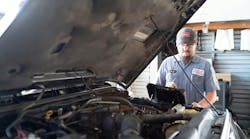My father, G "Jerry" Truglia, taught me about P0420s before I started full time in the automotive business. His advice? Test the oxygen sensors, try a burn off procedure and if the catalytic converter needs to be replaced get one from the dealer.
So, I begin running my own shop and by "osmosis" learn that all the shops in town were swapping out converters and oxygen sensors as their P0420 repair. It struck me as incredibly wasteful for the customer and a "repair" that would increase the likelihood of comebacks.
There are more comebacks for several reasons. First, most aftermarket converters that are sold by the majority of parts stores just don't cut it. They throw P0420s early or they don't even turn the check engine light off at all, because they have less precious metals inside which are the very ingredients that make the converters work. There's a reason why the scrap metal guy will give you about $100 for a used OE catalytic converter and only five or ten bucks for a used (even new!) aftermarket one.
Other reasons for comebacks are that the aftermarket oxygen sensors don't jive as well with the PCM as the OE ones and that the vehicle has a non-oxygen sensor/catalytic converter-related problem that is making the converter go bad. One such problem is that the system is running lean. One shop owner (who's a multi-millionaire) told me, "I only worry about that if the vehicle has a P0171 [lean code]."
I felt like replying, "Dude, have you ever seen a Chrysler with a P0171?"
Some vehicles will not easily set such DTCs so it is not wise to ignore that their elevated fuel trims, or other conditions such as misfires, are toasting the cat. If you are not fixing these, but swapping the cat, that's just a recipe for disaster.
Let me tell you my quick approach to P0420 diagnosis, and you guys can correct me if you want in the comments section:
1. Check fuel trims and DTCs.
Fuel trims +/- 7 or beyond and misfire codes give me reason to diagnose what's the real culprit (i.e. vacuum leak, exhaust leak, front oxygen sensor stuck lean, misfire, etc.).
2. Check rear oxygen sensor.
A rear oxygen sensor stuck lean will make a vehicle throw a P0420, especially on Toyotas. Usually this sensor is defective because an exhaust leak or something else leaned it out too long.
3. Check TSBs.
If the normal stuff checks out, it's worth checking TSBs. Before replacing converters, if there is a TSB for a reflash or a burn-off procedure, do it before replacing the cat.
4. If everything checks out, replace the converter and/or the specific oxygen sensor that's bad. No more and no less.
I never had a comeback doing it this way and I saved my customers tons of money. Now, I may never be a multi-millionaire like my "buddy" across the street doing it this way, but we are professionals. You wouldn't want your doctor doing unnecessary work on your body, so we shouldn't be doing unnecessary work on vehicles when there is a better way.


